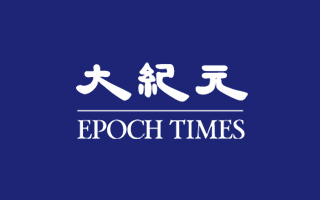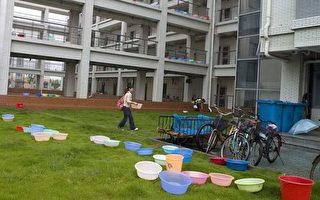【大纪元6月6日讯】China Daily December 17, 2004)
中国日报二○○四年十二月十七日电(注意时间)
Cleanup of Taihu Lake an Elusive Dream
太湖水清?一个虚幻的梦
In spite of ten years of treatment costing billions of yuan, the pollution in Taihu Lake continues to worsen. The 33.5 million people living around Taihu will probably have to wait another decade to drink clean water from the country’s third-largest freshwater lake.
对太湖污染的治理已经用去了数十年,耗资数十亿,情况却日渐恶化。有335万居民很可能需要继续等待另一个十年才能喝上清洁的水,而他们却生活在中国第三大淡水湖的周边。
Covering an area of 2,400 square kilometers in east China, Taihu Lake is a major source of drinking water for people living in Shanghai and east China’s Jiangsu and Zhejiang provinces.
太湖占据了中国东部2400平方公里的面积,是生活在上海,江苏,渐浙江一带人们的主要水源。
The Taihu Lake basin accounts for about 3 percent of the country’s land area and 8 percent of its population. Historically a rich and fertile area, it has become one of the most populous and prosperous regions in the country.
太湖盆地占据了整个中国百分之三的陆地面积,上面承载着百分之八的中国人民。它的富饶肥沃由来已久,已成为中国人口最为密集,经济最发达的地区之一。
But tremendous economic growth and the huge population of the area are putting the lake under increasing environmental pressure, resulting in deteriorating water quality in recent years.
然而,快速增长的经济和人口正在给太湖带来日益增加的生态压力,同时导致了近年来水质的恶化。(我上中学的时候课本上就说“要走可持续发展的道路,不能重复资本主义国家先污染后治理的老路”,现在看来,哼哼,真是说得比唱得还好听。)
During the past ten years, a number of projects have been completed to curb the flooding of Taihu Lake, Vice Minister of Water Resources Zhai Haohui said recently at a high-profile seminar in Shanghai. These projects established a framework for flood control and the utilization of water resources.
最近在上海举办了一场姿态鲜明(high-profile,这个词在修饰seminar时是不是这个意思?)的研讨会,水利副部长Zhai Haohui(这个人是谁?)说:“近十年内完成了很多的太湖防洪工程”。这些工程确定了防洪及水资源利用的基本模式。
The Ministry of Water Resources (MWR) reports that the first phase of Taihu Lake projects have produced 15.8 billion yuan (US$1.9 billion) in economic benefits, two-and-a-half times the original investment.
水利部称太湖工程第一期已带来158亿的经济效益,是投入的2.5倍。
”For example, these projects played an important role in combating the massive flooding of Taihu Lake basin in 1999, saving 9.2 billion yuan (US$1.1 billion),” said Sun Jichang, director of the MWR’s Taihu Lake Basin Administration Bureau.
“比如,这些工程1999年太湖盆地发洪水时扮演了重要的作用,挽救了92亿的资产”, Sun Jichang, 水利部太湖盆地管理司司长如是说。(实在抱歉,我实在不清楚这些官衔,胡乱翻一下好了,不过令我好奇的是原来经济效益可以这样算的,没有损失的就是赚回的?哪位达人给我解释一下,是不是中国的GDP也是这么算出来的?)
During the Taihu seminar held on December 3, Zhai pledged that people living in the area will be able to drink clean water from the lake by 2015.
在十二月三日举行的太湖研究会上,zhai立下保证说在2015年前,当地居民一定能喝上清洁的水。(还有八年,不知道他那时还在不在,谁能告诉我,他现在还在不在,这个消息是三年前的。)
However, experts say that the quality of the lake continues to deteriorate despite more than a decade of effort from both the central government and local authorities. Flood control standards are still low and the pollution of the lake remains serious.
但是,专家称尽管中央和当地政府共同努力了十年,太湖水质依然在恶化。防洪标准依然很低,污染依然很严重。(呵,共同努力了十年,这名话我怎么看怎么不对劲,算了不改了,时)
The lake’s environmental problems include accelerated eutrophication, or aging, caused by nitrogen and phosphorus enrichment. These materials cause an overgrowth of algae and further deterioration, including oxygen depletion. The lake is probably also contaminated with potentially toxic substances originating from increased agricultural, domestic and industrial activities.
太湖环境问题包括氮磷元素富集带来的富营养化。这些元素导致藻类的过快生长和进一步的恶化,包括水中氧气的耗竭。污染也有可能来自潜在的毒素,这些则应归因于不断增加的农业活动,居民活动和工业活动。
The State Environmental Protection Administration (SEPA) has been closely monitoring Taihu’s water quality, using 110 manned and three automatic surveillance stations scattered throughout the entire lake area.
国家环境保护局密切关注着大湖水质的变化,使用了散布在整个湖域的110个人力或自动化的监测站。(于是,在200年,这些监测站得出一个一个结论,天气变化,太湖水位下降,风向有异,纯属自然灾难。)
One of the basic causes of the pollution lies in sewage treatment measures lagging far behind the rapid social and economic development of the Yangtze River delta.
在扬子江流域,一个导致污染的最主要的原因是污水处理工艺远远滞后于社会和经济的飞速发展。(我faint,经济飞速发展,只有污水处理不发展,好像污水处理不能算是经济活动似的,这让我想起一个老共产党员语重心长地对我讲的话“年轻人,你们要少发点牢骚,发发牢骚,你们虽然开心了,可是对国家利益有什么好处呢”,原来我开心了我得到利益了是不算在这个国家利益里的,原来国家利益不是由许许多多的个人利益合起来的,那国家利益到底是个什么东西,谁能告诉我?那个谁谁谁,你凭什么把我们的利益都给代表了?)
In the early 1990s, experts estimated that the annual industrial sewage entering the lake would reach 540 million tons and household sewage would reach 320 million tons. Spot checks conducted in 2000 indicated that total sewage surpassed 5.3 billion tons.
早在九十年代,有专家估计每年进入太湖的工业污水将有5.4亿吨,生活污水将有3.2亿吨。在2000年进行的一项抽样调查显示,污水总排放量超过了53亿吨。
According to Sun Jichang, only 30 percent of the household sewage is treated before being dumped into the lake. Gao Erkun of the MWR added that standards and treatment capacity for sewage and wastewater have not been able to meet actual requirements.
据Sun ichang称,在排入太湖前,只有30%的生活污水得到了处理。来自水利部的Gao Erkun补充道污水废水处理标准及能力并不能满足实际需要。(各位,咱们来做一道计算题,5.4亿吨工业污水加上3.2亿吨生活污水减去30%处理后的生活污水是7.64亿吨,按纯水的密度1000千克每立方米算是7.64亿立方米,前文提到太湖的面积是2400平方公里,也即24亿平方米,7640除以24是0.318米。也就是说每年有31.8厘米高度的太湖水受到污染。太湖有多深?谁能告诉我?如果按照2000年53亿吨的排水总量算,则截止 2000年,已有2.208米高度的太湖水成为污水。不算不知道,一算吓一跳,原来太湖水如果不绿,那才叫见鬼呢!)
SEPA officials said by 2005, plants in the Taihu Lake region will have the capacity to treat 2.2 million tons of sewage per day, nearly 30 percent more than the 1.7 million tons per day required by the 10th Five-Year Plan (2001–05). A total of 243 projects will be constructed to treat wastewater and rubbish, remove silt and reduce contamination from farming and ships. These projects will cost 21.9 billion yuan (US$2.6 billion).
来自国家环境保护局的官员称:“到2005年时,太湖水域的水站每天将能处理200万吨的污水,超过第十个五年计划(2001-2005)中确定的每天170万吨近30%。总计243项工程将展开以处理污水及废弃物,清除淤积并减少来自农耕及船业的污染,整个计划将耗资219 亿。”(果真咱们早就改掉浮夸风了,您看看,五年计划,多么容易就被超越了。日均200万吨的污水处理能力,每年即能处理7.3亿吨污水,靠,这不快到 5.4 + 3.2 = 8.6亿吨了,怎么情况不是好转而是恶化了呢?答案见下文。)
But even if all the wastewater produced in this region is treated in accordance with current standards, it still exceeds the capacity of the basin, Sun said.
但即使所有的污水都按现行标准得到了处理,仍将超过太湖盆地的容载能力,sun说。(晕死,原来不是不知道问题出在哪,而是知道却没人去改变这个标准。)
The people and enterprises who have benefited from the region’s industrialization in the past two decades now have to pay for the treatment of wastewater and rubbish.
过去二十年中,当地人民及企业从工业化中受益良多,而如今,他们将为处理污水和垃圾而付出。(有没有人没受益到?看这话的意思,好像没受益到就不用付出了。)
Under the auspices of the State Council, some cities in the region have been seeking water resources through cross-regional transmission.
在State Council(国家委员会?)的资助下,部分太湖地区的城市将跨地域寻求水源。(这是我担心的原因之一,我真怕有一天,哪个专家拍拍脑袋,鄱阳湖的水就要被调到太湖去了,或者北京,我可爱的家乡啊,据说自己也快撑不住了。)
Cities like Suzhou, Changzhou and Wuxi that are neighbors of the Yangtze River have utilized river water to drive their rapid economic development for many years.
扬子江边的一些城市,例如苏州,常州和无锡,许多年来一直用江水资源来推动经济快速发展。
During the past three years, the Taihu Lake area borrowed more than 6 billion cubic meters of water from the Yangtze, half of which flowed into the lake itself.
过去三年内,太湖水域向扬子江借入了超过60亿立方米的水,其中一半流入了太湖自己。
But experts warn that a reasonable and cautious attitude must be adopted with regard to cross-regional water transmission.
但专家警告说,对跨域借水的做法,必须采取谨慎合理的态度。
”No doubt, the quality of the Yangtze and Qiantang rivers is better than that of Taihu Lake,” said Chen Jiyu, an academician with the Chinese Academy of Engineering. “However, it should be noted that these rivers themselves are suffering from increasingly serious pollution.”
中国工程院院士Chen Jiyu说:“毫无疑问,扬子江和钱塘江的水质要好于太湖,但是我们必须注意到,这些河流自己承受的污染也日益严重。“
The fundamental way to improve the quality of the lakes and rivers is to solve the pollution issue as well as adopting measures to save water, Chen stated.
Chen称:“改善江湖水质最根本的方法是解决污染问题,同时采取措施节约用水。”(我觉得,这好像是大家都知道的吧)(http://www.dajiyuan.com)
三年前太湖的水就不能喝了
人气 1
如果您有新闻线索或资料给大纪元,请进入安全投稿爆料平台。



